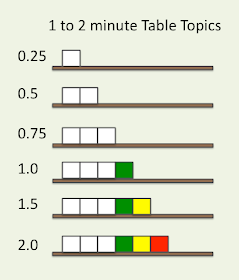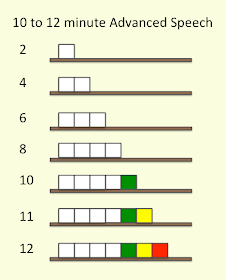At Toastmasters club meetings, along with timing each role, the Timer silently signals the speaker (or Table Topics Speaker, or Evaluator) when he has reached the minimum specified time, the middle of the time range, and the maximum specified time for that role. Typically this is done via a “traffic light” display with green, yellow, and red lights. For example, for the eight 5-to-7 minute speeches in the basic Competent Communication manual the green light gets turned on after five minutes, the yellow after six minutes, and the red after seven minutes. (Some clubs use simpler colored cards or flags).
But, why do we only provide feedback after five minutes? It seems to me that we have gotten stuck on the mechanics for speech contests, where the rulebook specifically calls only for a display at the minimum specified time, the middle, and the maximum. Most speeches in clubs aren’t contest speeches though. The timer has a stopwatch, so he could easily provide feedback at one minute intervals. Wouldn’t that reduce anxiety for our new speakers? Right now we expect them to remember to bring their own timer or stopwatch to the lectern. I recall some agonizing speeches where I either forgot to bring my timer, or forgot to start it.
A simple way to do this would be to have square, colored timing tiles that could be placed in a holder to create a mechanical progress bar display. The prototype is shown above. It displays the situation after seven minutes. Parts cost less than $25. Tiles are nine 5-inch squares cut from 3/16-inch thick white foam board. Edges were outlined using a black marker. Colors were added to three tiles by using two-sided tape to attach poster board (or construction paper). The holder is a four-foot length of 1-by-3 oak lumber with two pieces of 5/8-inch quarter-round molding nailed to it to make a 1/4-inch wide slot. (I used scraps of 1/4-inch thick wood at the ends as spacers). The basic idea behind this display is the century-old Gantt chart used in project management.
The above image shows how the timing tiles would be updated to track a five-to-seven minute speech. White tiles mark the first four minutes, followed by the usual green, yellow, and red. A final, optional black tile could be added to indicate that the speaker is running way over time and should sit down. Timing tiles also can be used for Evaluation and Table Topics.
The above image shows how the timing tiles would be updated to track a 2-to-3 minute evaluation. In this case the white tiles appear at 0.5-minute (30-second )intervals.
The above image shows how the timing tiles would be updated to track a 1-to-2 minute Table Topics speech. In this case the white tiles appear at 0.25-minute (15-second) intervals.
What about longer speeches, like the 8-to-10 minute Inspire Your Audience speech that is the tenth project in the Competent Communication manual? For speeches with a minimum time of 8 minutes or more the white tiles would appear at 2-minute intervals, and for speeches with 12 minutes or more they would appear at 3-minute intervals. The above image shows how the timing tiles would be updated to track a 10-to-12 minutes speech from one of the Advanced manuals.
What I have shown above is a simple, mechanical way to provide more feedback. As I previously described, this also could be done using a row of white and colored lights. Those who prefer using computers even could provide a continuous display of a speaker’s progress.





No comments:
Post a Comment